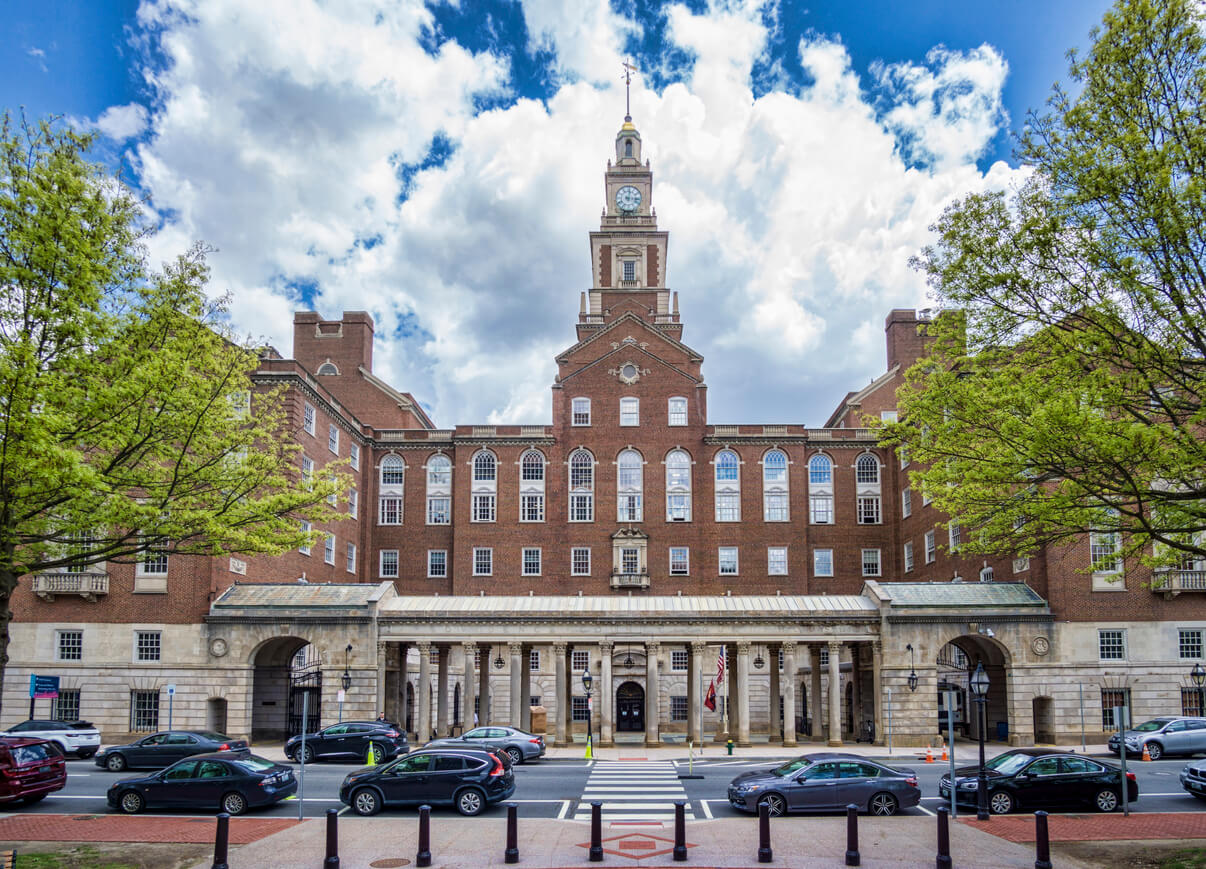
- $8.5 Billion Recovered
- Serves Clients Nationwide
- Rated #1 by U.S. News & World Report for 2022
Naval yards and older buildings such as schools, churches and city halls have all been sources of asbestos exposure in Rhode Island. Those with asbestos-related illnesses can file claims with a Rhode Island mesothelioma lawyer for compensation to cover medical expenses and other losses.

The easiest and most efficient way to file a claim in Rhode Island is to work with an expert. Hiring an experienced Rhode Island asbestos lawyer makes the litigation process more manageable and less confusing. They can help you navigate the state’s legal processes.
Key Facts About Filing in Rhode Island
Personal injury claims in Rhode Island must be filed within 3 years from the date of a mesothelioma diagnosis. You may file wrongful death claims within 3 years after the loss of a loved one.
An experienced Rhode Island asbestos lawyer can assess if there are any exceptions to state statutes in your specific case. But don’t wait to file your mesothelioma lawsuit. Waiting can delay receiving your compensation.
Hiring an experienced Rhode Island mesothelioma lawyer gives you access to expert legal counsel familiar with navigating the state’s specific legal procedures. Top mesothelioma lawyers will understand how to present your case to Rhode Island courts to get you the best outcome possible.
Working with an experienced attorney lets you and your loved ones focus on your treatment. Your lawyer will handle all aspects of litigation for you. Your lawyer will gather the essential documentation. They can manage a trial, if necessary, and work to negotiate with the defendant to settle. Most cases settle out of court.
A Rhode Island asbestos law firm can offer local knowledge that can help successfully build your case. Mesothelioma attorneys at these firms are educated about at-risk occupations and known exposures in the state. The quality and quantity of the evidence and witness testimony you present can impact the success of your case.
It’s important to choose a Rhode Island mesothelioma attorney at a top-rated law firm. They should not only have extensive knowledge of this area of the law, but direct experience successfully handling asbestos cases similar to yours.
Nationwide mesothelioma law firms may be the best choice for your case. They have the skills, experience and resources to go up against big corporations responsible for asbestos exposure. Choosing legal representation with firsthand experience taking on asbestos companies can give your case an advantage.






National law firms recognize their clients may not be able to travel to their offices. Top firms usually won’t charge to travel to you for the initial meeting. National firms can also explore all of your legal options, including lawsuits and asbestos trust funds.
Several asbestos verdicts and settlements have been reached in Rhode Island. Many past cases have led to millions of dollars in mesothelioma compensation.
Notable Rhode Island Settlements and Verdicts
Every mesothelioma case is unique. The average mesothelioma settlement depends on the details of the case. Settlements can range between $1 million to $2 million. Mesothelioma verdicts average higher. They can be between $5 million and $20.7 million. Speak with your mesothelioma attorney about any factors that can affect your claim.

Get help finding a top attorney who can get you the compensation you deserve.
Get Help NowBoth federal legislation and state laws govern asbestos in Rhode Island. State lawmakers have added additional layers of oversight regarding worker safety, building inspections and disposal practices. Rhode Island’s Asbestos Control Program protects the public from asbestos exposure, ensuring the provisions of the Rhode Island Rules and Regulations for Asbestos Control are followed.
The Rhode Island Department of Environmental Management enforces regulations on the handling and disposal of asbestos under the Air Pollution Control Regulations and Asbestos Abatement regulations. The rules require contractors to obtain proper certifications and follow specific asbestos removal and disposal procedures. The Rhode Island Department of Health must license contractors and workers involved in asbestos abatement.
Rhode Island Asbestos Laws and Regulations
In 2024, the owner of a Rhode Island asbestos abatement training center pled guilty to providing false documentation to the Rhode Island Department of Health about individuals completing an Environmental Protection Administration training program. Jose Virgilio Fernandez was charged with making false statements to RIDOH.
An investigation found that between 2021 and 2023, Fernandez submitted documents falsely certifying that nearly 24 people attended all days of instruction and achieved passing examination scores. However, no one attended the training. Fernandez later admitted to the EPA that, in many cases, he issued certificates to asbestos workers even though they didn’t participate in or complete the abatement class.
Rhode Islanders may have been exposed to asbestos if they worked in certain jobs, like manufacturing or shipbuilding. The most harmful asbestos exposure in Rhode Island occurred at places of employment. The state also has one naturally occurring asbestos deposit in Cumberland near the northeast state line.
Sites in Rhode Island Known for Asbestos Exposure
Three schools in Providence —Winsor Hill, Brown Avenue, and Sarah Dyer Barnes — were sources of asbestos exposure. More than 600 students, teachers and administrators in the schools may have been exposed to asbestos for as long as a year. The suspected exposure came from old asbestos-containing vinyl tiles ripped up during the summer of 1990.
The Rhode Island Department of Health closed the schools until the issues were resolved. Schools built before 1980 will likely contain some form of asbestos since it was a popular building material for classrooms, auditoriums, lounges and corridors.
Many occupations across Rhode Island have been a source of asbestos exposure. The state was once a leading source of textile production. That industry has a history of asbestos exposure since the mineral was commonly used in commercial cloth and fabrics. Other notable occupational asbestos risk sites include: Power plants, schools, manufacturing sites and shipyards.
Higher-Risk Jobs in Rhode Island
Rhode Island will hold companies responsible for cases of secondary asbestos exposure. Many people who worked in labor jobs during the 20th century worked directly with asbestos. Secondary exposure is more common in women and children.
They typically came into contact with asbestos in their home when a family member brought toxic fibers from work into the house on their clothes and shoes. Similar to primary exposure, secondary exposure can also lead to asbestos-related illnesses like mesothelioma decades after exposure.
Recommended ReadingYour web browser is no longer supported by Microsoft. Update your browser for more security, speed and compatibility.
If you are looking for mesothelioma support, please contact our Patient Advocates at (855) 404-4592
The Mesothelioma Center at Asbestos.com has provided patients and their loved ones the most updated and reliable information on mesothelioma and asbestos exposure since 2006.
Our team of Patient Advocates includes a medical doctor, a registered nurse, health services administrators, veterans, VA-accredited Claims Agents, an oncology patient navigator and hospice care expert. Their combined expertise means we help any mesothelioma patient or loved one through every step of their cancer journey.
More than 30 contributors, including mesothelioma doctors, survivors, health care professionals and other experts, have peer-reviewed our website and written unique research-driven articles to ensure you get the highest-quality medical and health information.
My family has only the highest compliment for the assistance and support that we received from The Mesothelioma Center. This is a staff of compassionate and knowledgeable individuals who respect what your family is experiencing and who go the extra mile to make an unfortunate diagnosis less stressful. Information and assistance were provided by The Mesothelioma Center at no cost to our family.LashawnMesothelioma patient’s daughter


Asbestos.com. (2025, January 28). Rhode Island Mesothelioma Lawyer. Retrieved March 7, 2025, from https://www.asbestos.com/mesothelioma-lawyer/rhode-island/
"Rhode Island Mesothelioma Lawyer." Asbestos.com, 28 Jan 2025, https://www.asbestos.com/mesothelioma-lawyer/rhode-island/.
Asbestos.com. "Rhode Island Mesothelioma Lawyer." Last modified January 28, 2025. https://www.asbestos.com/mesothelioma-lawyer/rhode-island/.
A mesothelioma lawyer who specializes in asbestos litigation reviewed the content on this page to ensure it is legally accurate.
William A. Davis is an attorney specializing in complex commercial litigation, with an emphasis in health care disputes, at a firm he founded in Washington, D.C. He also serves as senior counsel at The Peterson Firm.
Our fact-checking process begins with a thorough review of all sources to ensure they are high quality. Then we cross-check the facts with original medical or scientific reports published by those sources, or we validate the facts with reputable news organizations, medical and scientific experts and other health experts. Each page includes all sources for full transparency.
Please read our editorial guidelines to learn more about our content creation and review process.